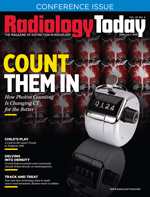 Editor’s Note: An Expanding Toolkit
Editor’s Note: An Expanding Toolkit
By Dave Yeager
Radiology Today
Vol. 23 No. 4 P. 6
The radiology industry is constantly iterating new tools to improve imaging and treatment, and in this issue, we cover a range of those tools. From more efficient photon counting to better tumor targeting, we have news on some of the most interesting advances. Read on to find out more.
This month’s cover feature examines photon-counting CT. Unlike previous iterations, photon-counting CT bypasses scintillation detectors and directly converts X-ray energy into electrical signals. Because the scanners retain data about individual photons, including the numbers of X-rays in various energy ranges, they are able to streamline the data collection process while improving noise suppression and spatial resolution. They also reduce radiation dose. Keith Loria has the details on page 12.
Another important type of measurement involves breast density. Beth W. Orenstein takes a look at AI tools that are helping to more accurately and consistently classify breast density on mammograms. With breast density being a critical factor in determining a woman’s risk for breast cancer, more effective screening has the potential to save lives. AI may reduce subjectivity in determining a woman’s level of density and, to date, the FDA has approved eight AI-based screening tools that address breast density.
Effective measurement depends on many variables, including patients themselves. This is especially true in relation to pediatric MR exams. MR requires patients to lie still, a tall order for wee ones who may be intimidated by large, noisy scanners. To help them feel more comfortable, and hopefully alleviate the fidgets, many vendors have developed kid-friendly MR tools that educate children and make the machines seem less scary. Loria has an update
on the latest trends.
Better measurement can also lead to more effective targeting. Orenstein reports on a machine that combines a PET/CT scanner with a linear accelerator to precisely target tumors and ablate them in real time. Known as biology-guided radiotherapy, the system is currently being used under the FDA’s Breakthrough Devices program to treat lung tumors, which are the most common cause of cancer death in the United States. The system uses PET radiotracers to turn tumors into biological beacons, making them easier to track in real time and allowing oncologists to deliver more precise and effective doses of radiation to the target. The system’s developers hope that its use will eventually be expanded to multiple targets and biological sites.
Enjoy the issue.
Dave Yeager

